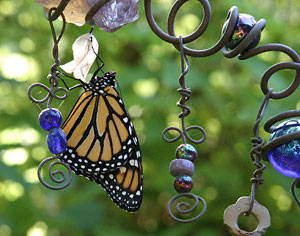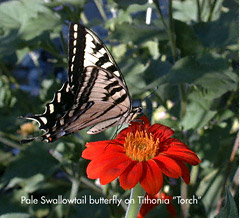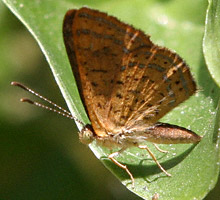Wildscaping
Welcome to Wildscaping, a site dedicated to helping fellow gardeners in Southern California learn how to attract and nurture wildlife in their own yards.
This site is rarely updated (since we moved to New Mexico!) but you can download the last plant list as a PDF here.
Best Recipe for Homemade Bark Butter!
Since moving to the mountains of New Mexico, where the winters bring freezing temperatures and snowstorms, our over-wintering birds love to eat "bark butter", a mix of lard, peanut butter and dry ingredients. We're posting our recipe on the Bark Butter page, in hopes that it will help others feed the birds in the colder months
Wildscaping has moved!
July 2008: After ten years of building a wildlife garden in Sherman Oaks, CA, Trish & Chris packed up and moved their home and business to the East Mountains of Albuquerque, New Mexico! This website will continue as is for now, as we have free hosting...
Birdy News
March–April '08: Lovely to see Mourning Cloak butterflies greeting the warmer days with a good flutter, following by Pale and Western Swallowtails. The Orioles returned again on St. Patrick’s Day or thereabouts. The song sparrows are busy nesting and are singing their little hearts out to impress potential mates; we believe there are three different songsters which bodes well for another good year for youngsters. Last summer, we had baby birds everywhere; a baby wrentit even made friends with its reflection in a window until it wised up! The California Trashers were heard along the fence where the ‘Roger’s Red’ grape was in fruit, but were otherwise fairly shy; we hope they return this year. The regular May migration usually brings Western Tanagers and warblers passing through. Check Birds for more on our feathered visitors.
Monarchs
 We released well over 100 monarchs in early 2007, but for the first time since we planted milkweed, we didn’t get our usual monarch migration in August–October. Friends all over LA were seeing monarchs (and being eaten out of house and home), but the flying jewels ignored our plants. Maybe they sensed we were so incredibly busy this summer/fall that we didn’t really have time to be cleaning out cages (or updating our website - sorry about that!). Finally we traded some plants for caterpillars in November, and are still releasing the adults (as weather permits) in early December. For more on raising monarchs, check out our Monarch Life Cycle page.
We released well over 100 monarchs in early 2007, but for the first time since we planted milkweed, we didn’t get our usual monarch migration in August–October. Friends all over LA were seeing monarchs (and being eaten out of house and home), but the flying jewels ignored our plants. Maybe they sensed we were so incredibly busy this summer/fall that we didn’t really have time to be cleaning out cages (or updating our website - sorry about that!). Finally we traded some plants for caterpillars in November, and are still releasing the adults (as weather permits) in early December. For more on raising monarchs, check out our Monarch Life Cycle page.
Overall, butterflies have been thin on the ground in 2007 due to the dry winter/spring; we mainly saw our regular Pale Swallowtails, Western Swallowtails, and Mourning Cloaks. However, despite 2006 being a banner year for American Painted Ladies (nesting in host plant Gnaphalium canescens), we saw no sign of these lovely ladies all year, despite some healthy host plants.
 By the way, our Tithonia (Mexican Sunflower) annuals were superb again this year, reminding us that it really doesn't matter what else is blooming, 10 out of 10 larger butterflies prefer Tithonia! Tithonia is a guaranteed butterfly magnet, so we always plant some seeds around May 1st, and (usually) you will have 3 ft plants blooming by August, and they bloom through November. Hummingbirds also enjoy the flowers, and the seeds are eaten by goldfinches. Picturered here is a Pale Swallowtail enjoying Tithonia.
By the way, our Tithonia (Mexican Sunflower) annuals were superb again this year, reminding us that it really doesn't matter what else is blooming, 10 out of 10 larger butterflies prefer Tithonia! Tithonia is a guaranteed butterfly magnet, so we always plant some seeds around May 1st, and (usually) you will have 3 ft plants blooming by August, and they bloom through November. Hummingbirds also enjoy the flowers, and the seeds are eaten by goldfinches. Picturered here is a Pale Swallowtail enjoying Tithonia.
Seeing Blue
 In summer, the garden is usually awash in Marine Blue butterflies whirling around their food plant, Baja Fairy Duster (Calliandra californica), which is also a big hit with the hummingbirds and orioles. There are possibly also some Ceraunus Blue, which is not unlike the Marine Blue.
In summer, the garden is usually awash in Marine Blue butterflies whirling around their food plant, Baja Fairy Duster (Calliandra californica), which is also a big hit with the hummingbirds and orioles. There are possibly also some Ceraunus Blue, which is not unlike the Marine Blue.
And yes, it is hard to focus on the markings of a one-inch butterfly that never sits still, but you'd be surprised how easy they are to photograph while ovipositing (laying eggs) as the females are soooo focused! Witness this Acmon Blue (right) laying eggs on Red Buckwheat (Eriogonum grande var. rubescens); she also used the cream flowers of the Sea Cliff Buckwheat (Eriogonum parvifolium). Notice how her abdomen curls down to deposit the egg, while her antennae point down as if to say “I’m really concentrating here!”. The caterpillars feed on the flowers, but we've yet to find any as they are so tiny.
Fatal Attraction
 It’s also not unusual to see little brown skippers nectaring in all corners of the garden, so many in fact that we often fail to really look at a small brown butterfly flitting around. But this little fella (right) caught our eye: The Fatal Metalmark (Calephelis nemesis) is a small butterfly, only 3/4" to 1" in size, found in coastal sage scrub and chaparral, usually along canyon bottoms. Click here for a view from above. Their food plant include Bush Sunflower (Encelia californica), which we have in the garden, and Mule Fat (Baccharis salicifolia), usually found in wetland areas.
It’s also not unusual to see little brown skippers nectaring in all corners of the garden, so many in fact that we often fail to really look at a small brown butterfly flitting around. But this little fella (right) caught our eye: The Fatal Metalmark (Calephelis nemesis) is a small butterfly, only 3/4" to 1" in size, found in coastal sage scrub and chaparral, usually along canyon bottoms. Click here for a view from above. Their food plant include Bush Sunflower (Encelia californica), which we have in the garden, and Mule Fat (Baccharis salicifolia), usually found in wetland areas.





